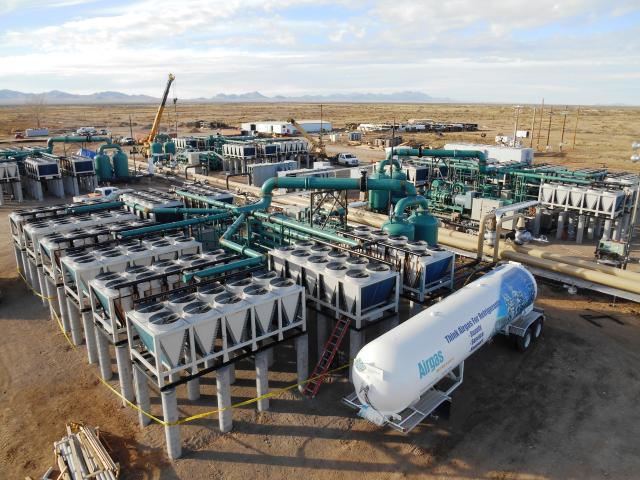BLM takes steps to accelerate geothermal energy development
WASHINGTON —The Bureau of Land Management has finalized a new categorical exclusion that will help to accelerate the discovery of new geothermal resources on public lands. The newly approved categorical exclusion will apply to operations to confirm the existence of a geothermal resource on public lands. The BLM is also proposing a categorical exclusion that will include activities related to the search for indirect evidence of geothermal resources.
Additionally, BLM announced its adoption of 23 categorical exclusions from agencies across the Federal government to reduce permitting times for low-impact projects, part of the Biden Administration’s continued efforts to improve Federal permitting and increase efficiency. The adopted categorical exclusions include tools that will aid in clean energy deployment and wildlife conservation, among other priorities.
Supporting Geothermal Energy
Replenished by heat sources deep in the Earth, geothermal energy generates baseload electricity with minimal carbon emissions. It can also heat buildings and greenhouses and support aquaculture operations. Today, there are 51 operating power plants producing geothermal energy from BLM-managed public lands.
Today’s action will help accelerate the discovery of new geothermal resources throughout the West, especially in states like Nevada, home to some of the largest undeveloped geothermal potential in the country. The new categorical exclusion applies to geothermal resource confirmation operations plan of up to 20 acres, which can include drilling wells (e.g., core drilling, temperature gradient wells, and/or resource wells) to confirm the existence of a geothermal resource, to improve injection support, or to demonstrate connections between wells.
Until now, geothermal developers had to conduct two separate environmental reviews: one for initial exploration drilling and another to fully test the geothermal resource, even if the initial exploration drilling would cause negligible or minimal environmental effects. The categorical exclusion applies only to geothermal resource confirmation operations on public lands and split estates. Subsequent geothermal development would still require additional environmental analysis. Based on DOE analysis, this categorial exclusion could take up to a year off the timelines for certain types of geothermal exploration permitting and reduce overall capital costs for geothermal deployment.
As of January 2025, the Biden-Harris administration has approved 46 renewable energy projects on public lands (12 solar, 14 geothermal, 2 wind, and 18 gen-ties) and exceeded the goal to permit 25 gigawatts of renewable energy by 2025. In total, the BLM has permitted clean energy projects on public lands with a total capacity of nearly 36 gigawatts of power – enough to power more than 15 million homes.
Accelerating Clean Energy and Resource Protection
The BLM also announced its adoption of 23 categorical exclusions from the Department of Energy, National Park Service, U.S. Fish and Wildlife Service, and National Telecommunications and Information Administration. The adopted categorical exclusions will help the BLM continue to deliver improved permitting to meet community priorities, including:
-
more efficiently siting clean energy projects near existing facilities, including recreation sites,
-
replacing and upgrading powerlines within existing powerline corridors,
-
building fencing along highways to protect migrating wildlife,
-
building EV charging facilities at BLM sites, and
-
better monitoring wildfire activity along powerlines.
BLM adopted these new categorical exclusions under Section 109 of the National Environmental Policy Act, enacted as part of the Fiscal Responsibility Act of 2023. Section 109 allows a Federal agency to “adopt” or rely on another agency's categorical exclusions to support their permitting reviews.
Additionally, BLM will be proposing a new categorical exclusion that would help accelerate exploration operations for geothermal energy which would include any activity relating to the search for indirect evidence of geothermal resources. The categorical exclusion would apply to geothermal exploration operations of up to 10 acres, which can include geophysical operations, exploratory drilling of core holes and temperature gradient wells, and temporary routes and trails. It will be published in the Federal Register tomorrow to begin a 30-day public comment period.
Under the National Environmental Policy Act, categorical exclusions are categories of actions that typically do not have significant impacts on the human environment. When used appropriately, the exclusions eliminate the need to prepare an environmental assessment or environmental impact statement. Before relying on a categorical exclusion for a proposed project, an agency must verify that there are no extraordinary circumstances, such as potential impacts to endangered species or cultural resources, that may result in the project having any significant environmental effects.
These categorial exclusions support the goals of the recent Executive Order on Advancing United States Leadership in Artificial Intelligence Infrastructure, which in part directs BLM to conduct a programmatic environmental review of its geothermal leasing program and identify priority areas for geothermal power on public lands.
The BLM manages about 245 million acres of public land located primarily in 12 western states, including Alaska, on behalf of the American people. The BLM also administers 700 million acres of sub-surface mineral estate throughout the nation. Our mission is to sustain the health, diversity, and productivity of America’s public lands for the use and enjoyment of present and future generations.

